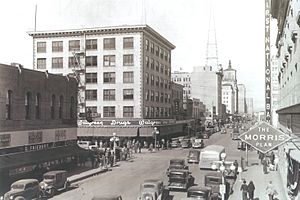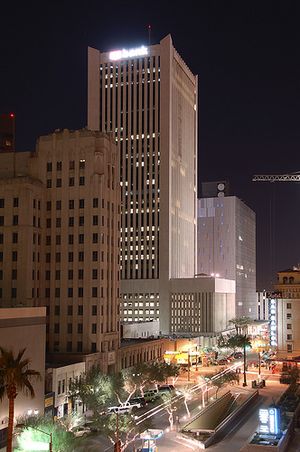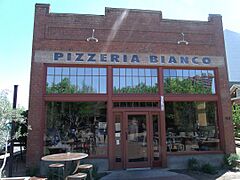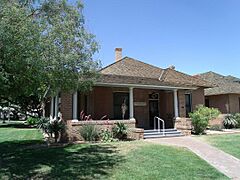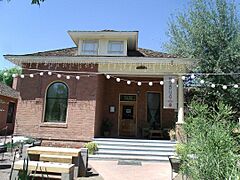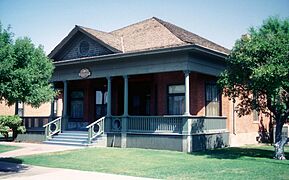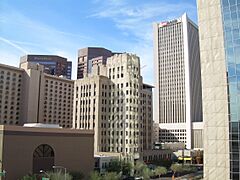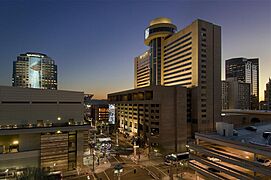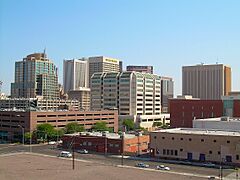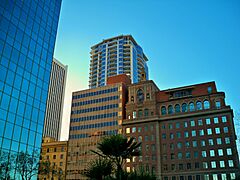Downtown Phoenix facts for kids
Downtown Phoenix is the main business area of Phoenix, Arizona, in the United States. It's right in the middle of the big Phoenix metropolitan area, also known as the Valley of the Sun. Phoenix is the capital of Arizona and the main city for Maricopa County. This means Downtown Phoenix is super important for local, state, and federal government.
Many big companies have offices here, making it a major place for jobs. You'll find lots of banks, law firms, and other businesses in the tall buildings. Downtown Phoenix is also home to cool museums, art places, and sports stadiums. It's a busy spot for major sports games and live concerts.
The City of Phoenix says Downtown is the area between 7th Street and 7th Avenue, from McDowell Road to Buckeye Road. But most of the action happens around Washington Street and Central Avenue. This spot is where all Phoenix street addresses start!
West of 7th Avenue, many state government offices are located. This area, up to 19th Avenue, is often called the Arizona State Capitol Complex.
Contents
History of Downtown Phoenix
How Downtown Phoenix Started
In 1870, people met to pick a spot for the growing town of Phoenix. They bought 320 acres for $50. This original area is what we now call the Downtown Core. It stretched from Van Buren Street to Jackson Street, and from Seventh Street to Seventh Avenue.
The new town was laid out in a grid, like a checkerboard. Washington Street became the main street going east and west. The streets going north and south were first named after Native American tribes. But they were later changed to numbers to make them easier to remember. Streets east of Central Avenue were called "Streets," and those to the west were called "Avenues." Phoenix kept growing and became an official city on February 28, 1881.
In the 1880s, Phoenix became more modern. It got one of the first electric plants in the West. Horse-drawn streetcars also started running. Later, these streetcars became electric and connected Downtown Phoenix to other parts of the Valley. In 1887, the first train arrived, which was a huge deal! It made it much easier for goods to come in and out of the city. As Phoenix became a major business hub, it also became the state capital.
Downtown's Big Growth
After Arizona became a state in 1912, Phoenix grew super fast, especially around Downtown. By the 1930s, you could see a modern skyline with many commercial buildings. Downtown was a busy, walkable city with Victorian buildings and shops at street level.
After World War II, many people moved to the suburbs. Cars became popular, and new cooling systems for homes meant people didn't need to live so close to the city center. This caused Downtown to become less busy for a while.
Downtown Gets a Makeover
After a tough economic time called the Great Recession, people became very interested in making Downtown Phoenix exciting again. Before the recession, most new buildings were in the suburbs. But now, the focus shifted to Central Phoenix. This meant building more tall buildings and focusing on local businesses, science, education, and art.
Arizona State University built a new campus Downtown, and the Convention Center also got bigger. These changes helped make Downtown Phoenix a great place for businesses. Areas like Lower Grand, Roosevelt, and the Warehouse District saw lots of new art, cool restaurants, and old buildings being used in new ways.
In February 2015, the Super Bowl was held in Arizona. Many of the big NFL events happened right on the streets of Downtown Phoenix. This showed everyone how much the city had changed! The new light rail system also brought many new building projects to Downtown Phoenix along Central Avenue.
Fun Things to Do in Downtown Phoenix
Downtown Phoenix has many cool places to visit. These include museums, sports arenas, and places for live shows.
Museums and Cultural Spots
Downtown has many museums and cultural places. You can visit the Arizona Science Center to learn about science. The Wells Fargo History Museum shows you about the old West. The Children's Museum of Phoenix is great for younger kids. You can also find the Phoenix Art Museum, the Rosson House Museum, and the Arizona Latino Arts and Cultural Center.
Universities and Learning
Many universities have a presence Downtown. Arizona State University, the University of Arizona, Northern Arizona University, and GateWay Community College all have buildings here.
Sports Action
Downtown Phoenix is a big sports hub! Chase Field is where the Arizona Diamondbacks baseball team plays. It has hosted big baseball games and even international soccer.
Footprint Center is home to the Phoenix Suns basketball team and the Phoenix Mercury women's basketball team. The Arizona Rattlers arena football team also plays there. This arena hosted the NBA All-Star game in 2009.
Downtown Phoenix has hosted many major sports events. In 2015, Super Bowl XLIX Central and the NFL Experience brought over a million people to the city center. In March 2017, Phoenix hosted the NCAA Final Four Championship. This event brought over 400,000 people to Margaret T. Hance Park and other Downtown spots.
Performing Arts Shows
Phoenix Symphony Hall is where the Phoenix Symphony performs. The Arizona Opera and Ballet Arizona also put on many shows here.
The Orpheum Theater was built in 1927 as a grand movie house. It had a big renovation and now hosts everything from Broadway shows to beauty pageants.
The Herberger Theater Center has three stages. It is home to three theater companies: Actors Theater, Arizona Theater Company, and Center Dance Ensemble.
The Comerica Theatre is a modern venue for concerts, Broadway shows, and boxing. It can hold up to 5,000 people.
Visitor Centers
Downtown has two main places to get information. Downtown Phoenix, at 2 E. Washington Street, helps manage the Downtown area. Visit Phoenix has a tourist center inside the Downtown Phoenix Convention Center.
Famous Buildings and Landmarks
- Luhrs Building & Tower – This was Downtown's first 10-story building in 1924. A taller 14-story tower was added in 1929. Both buildings are still here and have offices, restaurants, and shops.
- Hanny's – Opened in 1947, this was a top men's clothing store. Now, it's a fancy restaurant and bar.
- The Professional Building (Hilton Garden Inn) – Built in 1932, this was Phoenix's first medical office building. It's the largest building in Arizona covered in limestone.
- Maricopa County Courthouse (Historic City Hall) – This building was the City Hall from 1928 to 1994. It's a great example of Renaissance Revival style.
- The San Carlos – This hotel opened in 1928. It was the first hotel in Phoenix with evaporative cooling. Many famous people like Marilyn Monroe and Clark Gable stayed here. It's still a working hotel today!
- The Heard Building – When finished in 1920, this was Downtown's tallest building. It has housed the Arizona Republic newspaper and a radio station.
- St. Mary's Basilica – This is the oldest Catholic church in Phoenix. It was built starting in 1880 and is on the National Register of Historic Places.
- Chase Field – Opened in 1998, this stadium has a roof that can open and close over real grass. It's home to the Arizona Diamondbacks baseball team.
- Alwun House – This historic building is an art gallery that shows alternative and modern art.
Downtown Phoenix Architecture
Downtown Phoenix has over twenty-five tall buildings, some as high as 40 stories! Three of the five tallest skyscrapers in Arizona are right here. The Chase Tower is the tallest at 40 stories. The U.S. Bank Center is 31 stories tall. 44 Monroe is 34 stories high.
Downtown buildings show many different styles from the 20th century. You can see Beaux Arts style in the Security Building. Art Deco designs are on the Luhrs Tower and the Hilton Garden Inn. The International Style was popular from the 1960s to the 1980s, seen in buildings like the Chase Tower. The Post modern style, which brought back fancy decorations, can be seen in the Bank of America Tower and the Phoenix City Hall.
Recently, many people want to live in the city center. This has led to old buildings like the Phoenix Title and Trust building being turned into apartments called Orpheum Lofts. New apartment buildings like 44 Monroe have also been built.
Historic Heritage Square
Historic Heritage Square is a special part of Downtown Phoenix. It has the only group of original homes left from when Phoenix first started.
The Lath House Pavilion, built in 1980, looks like old-fashioned conservatories and gazebos. It hosts many festivals. The Rosson House is the most famous house here. It has been restored to look like it did in the Victorian era, and you can take tours.
Other homes in the square include:
- The Duplex, built in 1923, which had special sleeping porches to let in cool air.
- The Carriage House, built as a mule barn in 1899.
- The Silva House, built in 1900, which is now an English Pub called The Rose and Crown.
- The Bouvier-Teeter House, built in 1899, now a Victorian Tea Room.
- The Baird Machine Shop, built in 1929, now home to Pizzeria Bianco, famous for its pizza.
- The Thomas House, moved here to save it, now houses Bar Bianco.
- The Stevens-Haustgen House, built in 1901, shows the California bungalow style.
Phoenix's Historic Heritage Square gallery
Historic Neighborhoods
Downtown and Central Phoenix have many historic neighborhoods. They range from Victorian homes built around 1900 to modern homes from the mid-1900s. Some popular ones include Willo, Encanto-Palmcroft, and Roosevelt.
Encanto-Palmcroft Historic District
This neighborhood started in the late 1920s. It has winding roads, tree-lined streets, and beautiful gardens. It feels like an English suburb! The homes here are large and in styles like Spanish Colonial and Tudor Revival. It was once a quiet escape from the busy city.
Roosevelt Historic Neighborhood
This was the first neighborhood in Phoenix to be called "historic." It has a rich past, with important buildings and a role in Phoenix's early tourism. It was also one of the first "streetcar suburbs," meaning people could get around easily by streetcar. It's a true city neighborhood, great for walking, with local cafes and shops.
Willo Historic District
Willo Historic District is known as one of the top cottage communities in the U.S. It's easy to bike or walk to the light rail, businesses, and cultural spots. It was once a farming area and is still known for its green spaces.
Warehouse District
This area is just south of the main Downtown area. It used to be where Phoenix shipped farm goods and had its old Chinatown. Many old buildings here have been turned into new businesses, especially tech and creative companies.
Evans-Churchill Neighborhood and Roosevelt Row
This neighborhood is right next to the Downtown Core. It's home to Roosevelt Row, a famous arts district. Every first Friday of the month, this area hosts the largest monthly art walk in the U.S.! This neighborhood is becoming more friendly for walkers and supports small, local businesses. It has a mix of single-family homes and newer mid-rise buildings.
Downtown Phoenix in Movies and TV
Many movies and TV shows have used Downtown Phoenix as a filming location!
- Mel's Diner, near Downtown, was the setting for the TV show Alice.
- The 1960 film Psycho shows the Downtown Phoenix skyline in its opening shot.
- In the 1998 remake of Psycho, the opening shot zooms into the Westward Ho building.
- Parade scenes for the 1956 Marilyn Monroe movie, Bus Stop, were filmed in front of the Westward Ho.
- In Waiting to Exhale, Lela Rochon is shown in front of the Phoenix City Hall building.
- The film The Gauntlet features the Phoenix skyline and a big shootout in Downtown.
- Blue Collar Comedy Tour: The Movie was filmed at The Dodge Theater in 2003.
- In the 1978 TV movie A Fire in the Sky, a comet destroys Downtown Phoenix. You can see landmarks like the Wells Fargo Plaza and the Hyatt Regency Phoenix collapsing.
- The Arizona Center is used in the opening scenes of the 1998 film, Phoenix.
- The Paul Newman film, Pocket Money, used the Westward Ho courtyard in 1972.
- In October 2008, Luke Wilson filmed scenes throughout Downtown for Middlemen.
Gallery
-
44 Monroe, 2009



